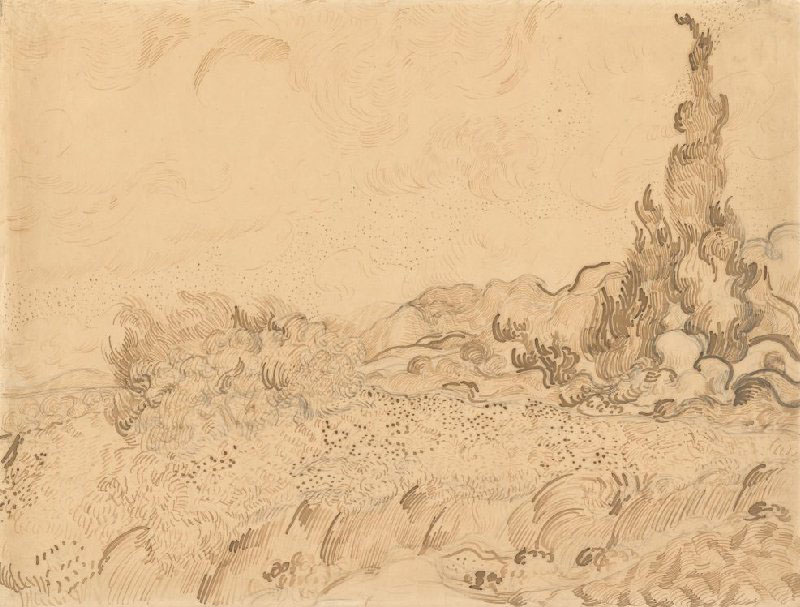Overview
In this lesson, students will use various types of lines and shades to describe how something feels, sounds, and moves.
Materials and Tools
- Drawing paper (two sheets per student)
- Drawing pencils
Objectives
Students will understand how to:
- There are many different types of lines that can be found all around us.
- Artists use different types of lines to describe how something feels, sounds, and moves.
- Artists can create dark, medium, and light shades by changing the pressure they put on their pencil.
Students will be able to:
- Draw a variety of lines.
- Create different types of shades with their pencil.
- Use lines and shades to describe 4-8 different types of weather.
Activities
Engagement
As a group, have students will identify the lines they see around them. Using their finger or arm, they can practice drawing each line in the air before drawing the line on their paper. Students can connect a sound to the line that they are drawing.
Examples of types of lines
- Straight
- Curvy
- Dotted
- Zigzag
- Diagonal
- Bumpy
- Swirly
On the same paper, have students change the pressure on their pencil to practice creating different shades.
Work Time
Have students fold a new sheet of paper into 4-8 sections. Share different types of weather (example list below) and have students use line(s) and shades to depict each. (Students should refrain from including words or images such as trees or animals in their drawings.)
Examples of types of weather
- A storm with thunder, lightning, and hard rain
- A very foggy morning
- A blizzard with snow and wind
- A very, very hot and humid day
- Light drizzle with a breeze
- A storm with hail and ice
- A sandstorm
- A tornado
- A dark, cloudy, windy day
Reflection
Prompts for Discussion
- How do different types of lines and shades describe how something feels?
- How do different types of lines describe how something sounds?
- How do different types of lines describe how something moves?
Additional Discussion Questions
- Can you find a line that you drew that looks like it would feel soft? What makes you say that?
- Can you find a line that you drew that looks like it would feel sharp? What makes you say that?
Writing Activity
Choose a type of weather from the art-making exercise and write a postcard to someone as if you are experiencing that weather in person. Use descriptive words to explain the scene.
- For example (dark, cloudy, windy day)
Greetings!
The sky is gray, and the air feels bitterly cold. The brisk wind is causing my hair to go in so many different directions. I need to buy a hat because the clouds look heavy and full of rain.
Sincerely,
_____(Name)
Sentence Prompt:
- I used ____________ lines (type of line) to describe ____________(type of weather).
Sketchbook Activity
Choose a type of weather from your exercise and sketch a weather scene. Make sure to include a lot of details and fill the whole page. How does the kind of weather effect what your drawing looks like?
- For example: If it is windy, what will the trees look like? If it is foggy, can you see the tree clearly?
Close-Looking Activity

- What kinds of lines do you notice?
- What words would you choose to describe this drawing? Why?
Vocabulary
Types of lines (zigzag, spiral, bumpy, horizontal, vertical, thick, thin, straight, curved, curly, wavy, jagged, dotted, dash, short, long, wispy, castle, crisscross), shades, pressure
Resources
- National Gallery of Art https://www.nga.gov/education/teachers/lessons-activities/elements-of-art/line.html
- The Squiggle by Carole Lexa Schaefer, illustrated by Pierr Morgan https://www.youtube.com/watch?v=k5oLRY79OZc
- Lines That Wiggle by Candace Whitman, illustrated by Steve Wilson
https://www.youtube.com/watch?v=a1I03hHWGhM - Julie Mehretu
https://www.moma.org/artists/25414


Adaptations
ADAPTATIONS FOR STUDENTS WITH DISABILITIES
- Think about the sounds a line might make or that you might hear if you stepped inside an artwork.
- Use motions, or your body, to make lines.
- Use sounds to describe lines.
- Use an iPad or Google Classroom to draw lines and shapes.
- Use the “Think, Pair, Share” strategy to partner students to help with understanding, verbalize ideas, and share their process.
ADAPTATIONS FOR MULTILINGUAL LEARNERS
- Multi-modality learning
- Total Physical Response (TPR)
- Provide visual examples
- Use equity sticks when calling on students
- Utilize visuals and realia to support words and concepts
- Use the “Think, Pair, Share” strategy
Extensions
- Exploring line through weather using watercolor or ink
- Landscape painting using watercolor or ink
- Drawing to music (sound/movement connection)
- Abstract collage using scissors to cut different lines that become shapes
Credits
Written By:
Belinda Blum, Artist Instructor
Lesson Development:
Julie Applebaum, Senior Director
Copyright © 2023 Studio in a School NYC LLC
